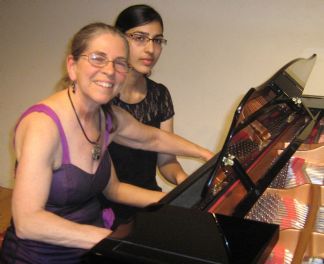|
Symphony
SRS SEASON ENDS WITH RESOUNDING TA-TA-TA-BANG
by Terry McNeill
Sunday, June 1, 2025
Symphony
YOUTHFUL VIRTUOSITY ON DISPLAY AT USO'S MAY CONCERTS
by Peter Lert
Saturday, May 17, 2025
Symphony
MYSTICAL PLANETS AND LIVELY GERSHWIN ORTIZ AT FINAL SRS CONCERT
by Peter Lert
Sunday, May 4, 2025
Symphony
VSO'S CONCERT MUSIC OF TIME, MUSIC OF PLACE
by Peter Lert
Sunday, April 27, 2025
Choral and Vocal
VOCAL ELEGANCE AND FIRE AT THE 222'S RECITAL APRIL 26
by Pamela Hicks Gailey
Saturday, April 26, 2025
CANTIAMO SONOMA SINGS AN INSPIRED GOOD FRIDAY MOZART REQUIEM CONCERT
by Pamela Hicks Gailey
Friday, April 18, 2025
DRAMATIC SHOSTAKOVICH SYMPHONY CLOSES PHILHARMONIC'S 25TH SEASON
by Terry McNeill
Sunday, April 13, 2025
LARGE COLLEGE OF MARIN AUDIENCE GREETS STOPHER ARTISTRY
by Terry McNeill
Saturday, April 5, 2025
Chamber
FRISSON DELIVERS SHIVERS OF DELIGHT
by Abby Wasserman
Sunday, March 30, 2025
OLD AND MOSTLY NEW IN SRS MARCH CONCERT IN WEILL
by Peter Lert
Saturday, March 22, 2025
|
 |
 Carolyn Tewari and Jasmin Aliakbari in Sebastopol Nov. 19 |
ALIAKBARI AND TEWARI SHINE IN SEBASTOPOL ARTS CENTER RECITAL
by Terry McNeill
Friday, November 19, 2010
Carolyn Tewari must be the most active performing pianist in Sonoma County. In addition to teaching, she has a full schedule playing in retirement homes, churches and concert halls, and has a penchant for music by women composers and partnerships with colleagues.
On November 19 she joined her duo partner of long standing, Jazmin Aliakbari, in a joint recital of eclectic music in the Sebastopol Center for the Performing Arts. The two women switched at the piano from primo to segundo with an enthusiastic audience of 40 watching every solo and four-hand alignment.
Jane Savage’s Duet, Op. 6, opened the program and was immediately forgettable. Glenn Gould referred to such compositions as “dictation music.” Debussy’s First Arabesque and Beethoven’s “Pathétique” Sonata, Op. 13, both performed by Ms. Tewari, were of course works of different merit. The Debussy featured a slow tempo with the stress on tonal color, the arching right-hand runs played with grace, and the legato triplets were stylishly rendered.
The Beethoven C Minor Sonata has been played in parts around the County by Ms. Tewari, and it was good that she finally tackled the entire work in a public hall. There was palpable momentum and drama in the playing, and left-hand tremolo passages had verve. Ms. Tewari was careful in the Adagio to keep one tempo throughout, and the concluding Rondo had perhaps the Sonata’s most concise playing, the long trill telling.
Poulenc’s Sonata for Four Hands closed the first half, Ms. Aliakbari joining in a clangorous change from the controlled pianism of the Beethoven. There was some unstable playing in the initial Prelude and beguiling juxtapositions of ruminative sound in the “Rustique” second movement. The counterpoint was clear in the finale, with lots of rumbling passages in the low bass and echoes of Poulenc’s large Concerto for Two Pianos. The last chord was held to considerable effect, the playing on balance the best in the first half.
Solo performance returned after intermission when Ms. Aliakbari played Bach’s Toccata in E Minor (S. 914), Chopin’s Third Ballade and the “Suite de Danzas Criollas,” Op. 15, of Ginastera. Though the Bach had good differentiation of voices, and the A-Flat Ballade featured clear right-hand scale passages, neither seemed a work that was yet fully the pianist’s own. The footing in each seemed unsure, the phrases hurried when repose was needed, the dense Bach fugal section lacking a concrete shape. The Ginastera work, from 1946 and similar in parts one and five to the earlier “Danzas Argentinas,” had an idiomatic reading from the pianist, the Creole style palpable and the clusters in the Allegro Rustico powerful indeed.
Four pieces from Grieg’s Peer Gynt Suite No. 1, Op. 46, concluded the formal program. The majestic nostalgia of “Morning Mood” and the singing treble line of the “In The Hall of the Mountain King” were salutary. No author of the transcription for piano four hands was listed.
A final charming work for both artists, the iconic “Tea For Two” from the 1925 Broadway show “No, No, Nanette,” was offered as an encore. It was a tuneful end to a pleasurable evening of rich solo and four-hand piano music.
|

